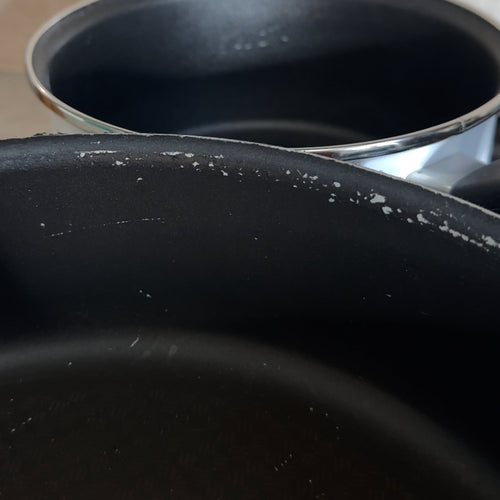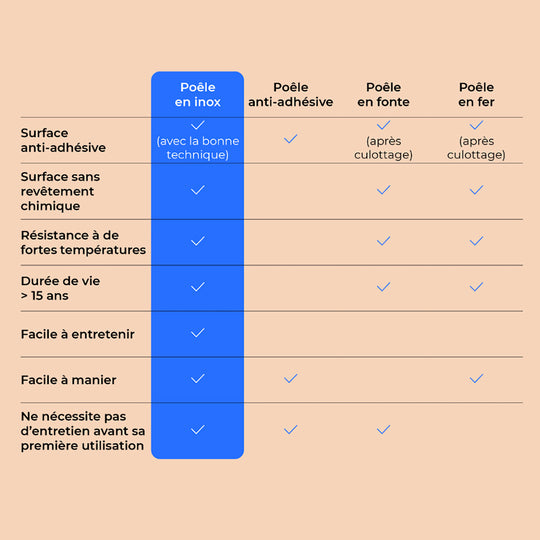What are the risks associated with non-stick coatings?








But what does "healthy cooking" really mean?
Let's take a moment to review the risks associated with using current non-stick coatings.
When we started developing La Bonne Poêle, we were obviously interested in all the coatings available on the market, including non-stick coatings known for their practicality. To be honest, what we read didn't really excite us, not at all. That's why we chose a 100% stainless steel coating for our cookware.
A few explanations before we begin...
Current non-stick coatings are mostly composed of PFAS or ceramic. Non-stick coatings containing PFAS represent more than 80% of the current market. They are indeed more efficient and last longer, but they are also highly controversial. It is therefore high time to separate fact from fiction to understand the issues in concrete terms.
What are PFAS?
PFAS is the acronym for per- and polyfluoroalkyl compounds, which are a family of more than 4,000 chemical substances with diverse properties. PFAS have been widely used since the 1950s in industry and many everyday products for their non-stick, waterproof, and heat-resistant properties. They are therefore used in the non-stick coatings of your cookware, but also in many textiles, certain food packaging, some cosmetics, and even plant protection products.
One of the best-known subfamilies is PFOA (perfluorooctanoic acid), found in particular in Teflon, the manufacture and use of which has been banned in Europe since 2019, and PFOS (perfluorooctane sulfonate).
The level of contamination in the French population was measured by the Esteban study published in 2019 by Santé Publique France. It was conducted on a sample of 744 adults (18-74 years old) and 249 children (6-17 years old) over two years (2014 to 2016). 17 PFAS were screened for. The results showed that 7 were regularly quantified in adults and 6 in children. PFOA and PFOS were identified 100% in the children and adults in this study. Some scientists estimate that 99% of the population has traces of PFAS in their bodies.
What are their impacts on health and the environment?
These substances are among the most stable chemical compounds. This means they degrade very little after use or release into the environment. This is why they are sometimes called forever chemicals. The presence of PFAS in the environment is solely due to human activity. Due to the wide use of these chemical compounds and their persistence, all environments can be affected: water, air, soil, and the food chain.
PFAS can pose a health risk with repeated exposure.
The latest studies indicate a link between PFAS exposure and the following health effects:
- Effect on the immune system in children (poorer response to vaccines);
- Decreased birth weight;
- High cholesterol levels;
- Disruption of liver function;
Other effects have been highlighted by toxicological studies on animals, such as endocrine disruption (hypothyroidism), effects on reproduction (reduced chances of pregnancy), and an increase cancer risk (kidney or testicular cancers).
PFOA was classified as a "probable carcinogen" by the International Agency for Research on Cancer in 2016. Most scientific research has focused on PFOS and PFOA to date. Knowledge of the effects of most other PFAS is still limited, particularly regarding their carcinogenicity.
A report by the Nordic Council of Ministers, an intergovernmental organization created by the Nordic countries (Denmark, Iceland, Norway, Sweden, and Finland), estimates that 15.6 million Europeans are affected by pathologies due to exposure to PFAS.
We won't paint you a picture, it's anything but healthy.
What are the current and future regulations?
To date, only certain PFAS are regulated, and there are still few applicable regulations in Europe and France. The status of PFOS and PFOA is governed by the Stockholm Convention of May 22, 2001, and European Regulation (EU) 2019/1021 of June 20, 2019, on persistent organic pollutants. The principle is to ban the manufacture, marketing, and use of these substances.
Some states are going further and have already prohibited certain uses of PFAS, such as Denmark, which, since July 2020, has banned their use in food packaging.
In France, PFAS in the broadest sense are the subject of a ministerial action plan led by the Ministry of Ecological Transition and Territorial Cohesion. The 2023-2027 PFAS action plan aims to strengthen the protection of French citizens and the environment against the risks associated with these substances.
For its part, Europe is accelerating the regulation of PFAS in the broadest sense and could enact a complete ban. In January 2023, three Member States contacted the European Chemicals Agency to open a six-month consultation on banning the manufacture and use of PFAS in Europe. This consultation ended last September. The results of this consultation should be known in 2024 and could lead to a ban on PFAS in European Union Member States starting in 2026/2027.
In conclusion, we're not trying to spoil the mood here, but to share the results of our research and reading. The impact of repeated and long-term use of PFAS on health is proven, as is its impact on the environment. Measures are being taken in France and at the European level, and the regulation of the use of these chemicals could become more stringent in the coming years.
As we mentioned in the introduction, don't worry, because alternatives exist! Stainless steel, in particular, is a material that poses no risk to your health and is sustainable because it is infinitely recyclable. That's why our Bonne Poêle is 100% 3-ply stainless steel for efficient and healthy cooking.
Conclusion: Which type of pan should you choose?
To go further and explain why we favor stainless steel for our cookware, here is a summary table of the advantages of 18/10 stainless steel. We also invite you to read our article explaining How to choose the coating for your pans.

Sources
- https://www.ecologie.gouv.fr/plan-daction-ministeriel-sur-pfas
- https://ww w.auvergne-rhone-alpes.ars.sante.fr/mieux-comprendre-les-pfas-leurs-effects-les-textes-applicables#:~:text=Les%20effects%20des%20PFAS%20sur%20l a%20health%C3%A9&text=effect%20on%20the%20immune%C3%A8me%20system,disruption%20of%20functioning%20of%20liver.
- https://www.efsa.europa.eu/fr/news/pfas-food-efsa-assesses-risks-and-sets-tolerable-intake
- https://www.lesechos.fr/weekend/planete/pfas-ces-produits-chimiques-eternels-qui-inquietent-1915141#_ftn1
- https ://www.lemonde.fr/les-decoders/article/2023/02/23/polluants-eternels-quels-sont-les-effects-des-pfas-sur-la-sante_6162939_4355770 .html#:~:text=Of%20multiple%20diseases%20are%20observed%C3%A9es,particular%20%C3%A0%20one%20exposure%20to
- h ttps://norden.diva-portal.org/smash/record.jsf?pid=diva2%3A1295959&dswid=9794
Discover our best sellers
By Victor Desport






























































